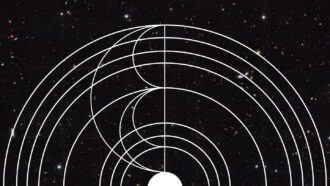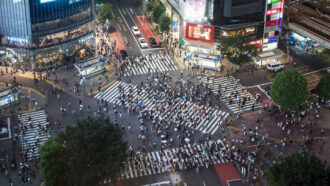Here are the Top 10 threats to the survival of civilization
From aliens and asteroids to pandemics, war and climate change, life as we know it is at risk

Civilization’s downfall could be initiated in many ways, with climate change and subsequent rising sea levels a prime candidate.
Peter Zelei Images/gettyimages
Civilizations don’t last forever. Just ask the Aztecs. Or the Maya. Or fans of the original Roman Empire.
From the ancient Myceneans in the Mediterranean to the Anasazi in Arizona, societies throughout history have often gone the way of the dinosaurs and the dodo. Wars, or disease, or altered weather patterns, or natural disasters, or famine have repeatedly tipped complex regional societies past the point of stability, initiating chaos, ruin and ultimately total demise.
In his original unabridged dictionary, published in 1828, Noah Webster defined civilization as “the state of being refined in manners, from the grossness of savage life, and improved in arts and learning.”
Today civilization is a lot more complicated. Now civilization connotes global complexity and technological sophistication beyond anything Webster would have recognized. Civilization has become a state “marked by urbanization, advanced techniques (as of agriculture and industry), expanded population, and complex social organization,” as the most recent unabridged Webster’s dictionary describes it.
Civilization’s current stability depends on a vast global interdependence of countless connected components. Food and fuel, materials for manufacturing, clothing and housing — all require the cooperation of individuals, corporations and nations. Transportation, communication, economic activity anywhere affect everything everywhere (sometimes, all at once).
So far, the economic and social structures, governmental agencies and relevant public policies have managed to maintain something resembling Webster’s recent definition. But all that is under threat. Civilization is on the brink of breakdown. There’s no guarantee that 21st century civilization will last till the 22nd.
In fact, humankind now faces a multitude of credible existential threats of which everybody ought to be aware. Lack of space, though, requires that immediate warnings herein be restricted to the Top 10 Threats to the Survival of Civilization, with relevant movies noted. (Note to The Last of Us fans — fungal zombie apocalypse would have been No. 11.)
10. Alien invasion
Relevant movie: The War of the Worlds
An assault on Earth by extraterrestrials isn’t exactly likely anytime soon. Even if enemy aliens are out there, they’d have to come a really long way for no good reason. Surely they’ve monitored Earth’s TV and radio output and would decide to look for intelligent life elsewhere.
Nevertheless, if spacefaring aliens did attack, they could easily destroy all earthly civilization. Even if they appeared to be friendly at first, don’t be fooled by a gift book from them titled To Serve Man. And don’t think Earth’s microbes will save us like they did in The War of the Worlds. If aliens possessed the technological capability for interstellar travel, they would also be smart enough to wear a damn mask.
9. Asteroid impact
Relevant movie: Armageddon
Not an immediate concern, yet more likely than an alien invasion. After all, an asteroid has already wiped out civilization on Earth once before. True, dinosaur civilization didn’t have the same kind of technology human civilization does. But a sufficiently big asteroid would certainly take down a lot of modern technology, and subsequent fires followed by global cooling (a Game of Thrones version of winter) would make a mess of the rest.
8. Bees all die
Relevant movie: Bee Movie
According to Twitter, if bees all die, humans will soon all be dead as well. That prediction appears to derive from an Albert Einstein quote found widely on the internet: “If the bee disappeared off the face of the Earth, man would only have four years left to live.” Such a quote does not appear in the standard compilation of Einstein quotations, though, and nobody seems to have any evidence that he ever said it.
Still, the demise of the bees would be disastrous. Their pollination of important crops (coffee beans, for instance) keeps the world going. Bees are not the only important pollinators of course, but if some combination of pesticide poisoning and other calamities wiped out bees and other pollinating insects and animals, the consequences for humankind’s food supplies would be dire. Animal pollination is of at least some importance for the majority of the world’s food crops, a 2007 study concluded.
Still, it’s unlikely that the human race would die out completely without pollinators. But civilization would probably collapse as the food chain (or web) unraveled, and there was no coffee.
7. Artificial intelligence takeover
Relevant movie: The Terminator (or Colossus: The Forbin Project)
A vast literature already exists describing the threats that artificial intelligence poses to civilization. Most such threats are minimal now, but as AI systems become more widespread, and both software and hardware become more sophisticated, AI’s destructive potential will pose an accelerating threat. A 2018 paper identified dozens of scenarios for AI-generated global catastrophe.
For example, in a future in which civilization relies extensively on robots, a computer virus with AI capability could become a weapon for a malevolent cyberattack. “If the attack is on a very large scale, affecting billions of sophisticated robots with a large degree of autonomy, it may result in human extinction,” wrote Alexey Turchin and David Denkenberger.
And of course, putting AI in charge of things like nuclear weapons might easily become just as dangerous in real life as it is in the movies. Already the military makes use of AI technologies and, in the future, will no doubt employ AI-powered drones and other robotic weapons with increasing frequency. “Military robotics could become so cheap that drone swarms could cause enormous damage to the human population; a large autonomous army could attack humans because of a command error; billions of nanobots with narrow AI could be created in a terrorist attack and create a global catastrophe,” note Turchin and Denkenberger.
6. Quantum computing
Ordinary AI has the potential to be risky enough, so it shouldn’t be surprising to discover that quantum computing, in principle a much more powerful technology still in its infancy, poses even more serious dangers. Overhyped as it frequently is, quantum computing nevertheless might someday be able to perform specific tasks dramatically more rapidly than today’s supercomputers. One such task might be simulating the interactions of atoms and molecules in order to design new drugs or other chemicals.
“Quantum simulation … offers an exponential quantum speedup in understanding reaction mechanism in molecules and probing the properties of new materials,” quantum scientist Benjamin Schiffer wrote in a paper last year.
In malevolent hands, such power would also enable design of more effective poisons. Using quantum computers, a novel pandemic agent could be engineered without the need for time-consuming ordinary chemical trial and error. “There is an existential threat to humanity arising from the prospect of being able to run quantum simulations on a quantum computer in the future,” Schiffer argues.
5. Complexity’s instability
Relevant movie: The Butterfly Effect (title only — actual movie is irrelevant)
Any sufficiently complex system is at risk of reaching a tipping point where the slightest disturbance can initiate a collapse. So a seemingly insignificant event can trigger an apocalypse. It’s like the way at some point adding a single grain of sand to a large sandpile can cause it all to come tumbling down. Or the snap of a twig initiating an avalanche. Such complex systems seem stable because their complexity conceals underlying vulnerability. But the math exists to analyze such systems and predict their demise.
In 2000, geophysicists Didier Sornette and Anders Johansen warned that such analyses forecast a collapse of human population growth along with the mother of all economic crashes in the 2050s. Obviously, the economy and human population growth are key aspects of civilization as a whole. So these forecasts “point to the existence of an end to the present era, which will be irreversible and cannot be overcome by any novel innovation,” Sornette and Johansen wrote.
In a 2013 paper, Sornette and Peter Cauwels compared the silent march to catastrophe to the phenomenon of “creep” in materials, where small, unnoticeable cracks accumulate until the material suddenly fractures. It’s like society today is a lobster that thinks it’s getting a nice, pleasant bath and doesn’t notice the water getting warmer until it’s too late. For the world at large, the result might very well be a “blood red abyss,” Sornette and Cauwels wrote, the “likely and very painful final stage of creep … ending in the failure of existing institutions.”
4. Social media
Relevant movie: Don’t Look Up
It’s already evident that social media platforms have amplified ideological idiocy propagated to deter efforts to prevent or diminish many of the threats to civilization. Anti-vaccination propaganda is a prominent example, as is the effort to dispel the dangers of climate change and block efforts to address it. Social media enables disseminators of falsehoods to manipulate the masses and intimidate governments (as well as many organizations within the supposedly legitimate mainstream media).
On its own, social media might not destroy civilization totally, just eliminate civilized discourse. But combined with other options for vast destruction, social media could accelerate civilization’s devastation while impeding efforts to prevent it.
3. Pandemic(s)
Relevant movie: I Am Legend
You would think that a pandemic that has killed more than a million Americans and many millions more people worldwide would launch a serious effort to guard against future pandemics. Instead, the pandemic has led not to strengthening of public health measures, but an official response telling everybody they’re on their own.
Institutions charged with protecting public health now say individuals should weigh their own risks, but do not provide the necessary information to weigh those risks, and ignore the fact that the vast majority of people do not possess the expertise needed to weigh risks intelligently anyway. Making pandemic mitigations a personal choice is very much like saying people should decide for themselves whether to obey stop signs or run red lights. Consequently, a future pandemic as infectious as COVID-19, but with a much higher fatality rate, could kill enough people to shred the social fabric.
This danger has long been foreseen, but mostly ignored. In 1988, molecular biologist and Nobel laureate Joshua Lederberg lamented complacency about the threat of global epidemics, and warned that viruses and other microbes are formidable foes in a never-ending competition for planetary domination. “In that natural evolutionary competition,” Lederberg wrote, “there is no guarantee that we will find ourselves the survivor.”
2. Nuclear war
Relevant movie: Dr. Strangelove
After World War II, nuclear war was the most likely end-of-civilization scenario, and it certainly became a popular theme for fictional accounts of civilization’s demise. After the fall of the Soviet Union in 1991, though, many people who had been holding their breath since 1945 permitted themselves to exhale. But as long as nuclear arsenals remained undismantled, the threat continued, and now it may be greater than ever.
In January, the Bulletin of the Atomic Scientists pushed its famous doomsday clock to 90 seconds before midnight, the closest to global catastrophe in the clock’s history. The publication’s science and security board released a statement saying the new time was motivated largely, but not exclusively, by Russia’s war on Ukraine. “Russia’s thinly veiled threats to use nuclear weapons remind the world that escalation of the conflict — by accident, intention, or miscalculation — is a terrible risk. The possibility that the conflict could spin out of anyone’s control remains high.”
And António Guterres, the secretary-general of the United Nations, declared last year that the world now faces a time of nuclear danger as great as during the height of the Cold War. “Humanity is just one misunderstanding, one miscalculation away from nuclear annihilation,” he warned.
And of course, if Russia doesn’t initiate nuclear holocaust, there’s always North Korea, China, Iran and a bunch of other countries.
1. Climate change
Relevant movie: Princess Mononoke
Scientists have been warning for more than a century that carbon dioxide emissions could alter the planet. Higher average temperatures, hotter summers, melting sea ice, severe droughts, more wildfires, more powerful hurricanes and yes, even stronger winter storms are already signaling that climate change is not a myth. International efforts to agree on steps to limit rising carbon dioxide levels have stumbled. Study after study has detailed the numerous negative consequences for agriculture, human health and social well-being. Catastrophic climate change could instigate wars, famine, revolution.
Efforts to mitigate climate change might save civilization of course. But if such efforts fail, the worst-case warming scenarios are truly apocalyptic, as Luke Kemp and coauthors warned last year in the Proceedings of the National Academy of Sciences. “There is ample evidence that climate change could become catastrophic,” they wrote. They point out that climate change has played a part in the collapse of many regional civilizations. (There’s a reason why most people have never heard of the Natufian hunter-gatherers of Southwest Asia.) Uncertainties about future climate are great enough, those authors contend, to warrant serious investigation into the prospect that climate change could result “in worldwide societal collapse or even eventual human extinction.”
Of course, most of the risks to the civilization are not isolated threats. Climate change could trigger wars (see No. 2) or contribute to the spread of infectious diseases (No. 3), Kemp and colleagues note. And a United Nations report last year found that analyses of numerous related systemic risks “show a dangerous tendency for the world to move toward a global collapse scenario” in “the absence of ambitious policy and near global adoption and successful implementation.” In other words, without worldwide cooperation, “total societal collapse is a possibility.”
Both Kemp and colleagues and the authors of the U.N. report emphasize that these warnings are not predictions but calls to action. Listing threats is not for the purpose of overdramatizing them or to suggest that everybody should surrender to an inevitable existential catastrophe.
Behavioral scientist Caroline Orr Bueno, one of the few sane voices who offsets Twitter’s threat to civilization with insight and intelligence about misinformation and the techniques for spreading it, warns that scaring people “makes them reject the message.”
“The key is to get people to perceive that the threat is real,” she tweets, “but also that there are things we can do to effectively reverse the threat.”
And therein lies the hope.
Warnings of potential catastrophes should not be taken as cause for despair, but as motivation for investigating the dangers. “Analyzing the mechanisms for these extreme consequences could help galvanize action, improve resilience and inform policy,” Kemp and colleagues write. After all, when drought dissolved the Natufians’ civilization 10,000 years ago, they had no power to affect the climate. Modern humans do have such power. They could, in principle, stop using that power to make things worse and take steps to restore civilization’s safety and stability. At least until the aliens arrive.








